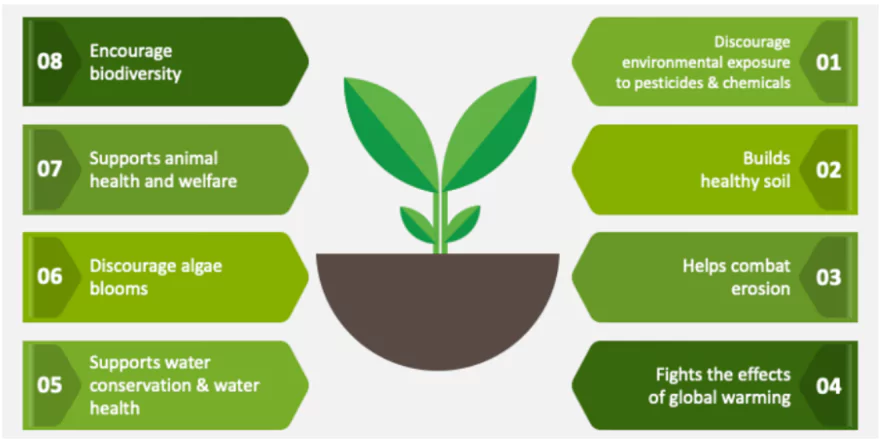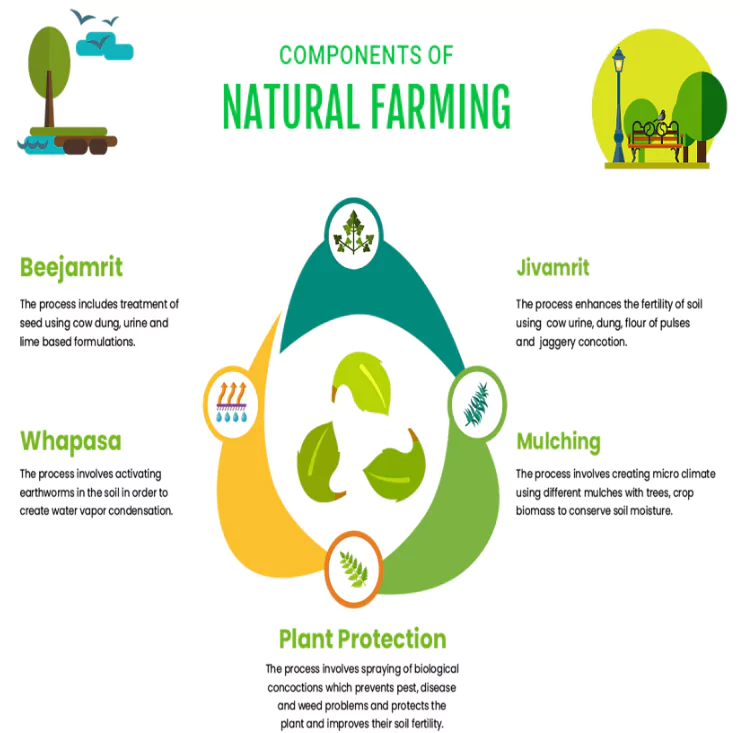Recently, the Union Government launched the National Mission on Natural Farming (NMNF) to promote its pet project of natural farming.
- The NMNF will be a standalone centrally-sponsored scheme under the Ministry of Agriculture and it will have a total outlay of ₹2,481 crore.
About Natural Farming
- Natural Farming is a chemical-free and livestock-based farming approach.
- It integrates crops, trees, and livestock, promoting biodiversity and agro-ecological balance.
- It is considered a form of regenerative agriculture globally, focusing on restoring soil health and reducing greenhouse gas emissions.
- It was introduced by Masanobu Fukuoka in his book The One-Straw Revolution (1975).
- It is promoted in India as Bhartiya Prakritik Krishi Paddhati Programme (BPKP) under Paramparagat Krishi Vikas Yojana (PKVY) to encourage traditional practices and minimize external inputs.
Enroll now for UPSC Online Course
About National Mission on Natural Farming (NMNF)
- It is a Centrally Sponsored Scheme implemented under the Ministry of Agriculture & Farmers’ Welfare.
- The total financial outlay for the scheme is ₹2,481 crore till the end of the 15th Finance Commission (2025-26).
- The Centre will contribute ₹1,584 crore, while the States will contribute ₹897 crore.
- Vision:
- To implement self-sustainable and self-generating natural farming systems for freedom from purchased inputs with the aim to cut down on cost of cultivation, enhance farmers income and ensure resource conservation and safe & healthy soils, environment and food.
Key Objectives of NMNF
- Promotion of Chemical-Free Farming: The mission aims to promote Natural Farming (NF) as a chemical-free, sustainable farming method based on traditional knowledge and practices.
- Economic Support to Farmers: It seeks to reduce input costs for farmers and minimize their dependence on externally purchased inputs.
- Nutritional Security: The mission is designed to provide safe and nutritious food for all by improving farming practices.
- Environmental Sustainability: It aims to rejuvenate and maintain healthy soil ecosystems, promote biodiversity, and support diverse cropping systems suitable to local agro-ecological conditions.
- Climate resilience: NMNF is intended to build climate resilience by addressing risks such as waterlogging, floods, and droughts.
- Market Accessibility: The mission will introduce an easy and simple certification system and common branding to support farmers in marketing their natural farming produce.
Implementation Strategy
- Cluster Development
- Create 15,000 clusters in willing Gram Panchayats over the next two years.
- Train one crore farmers and implement NF practices on 7.5 lakh hectares of agricultural land.
- Bio-Input Resource Centres (BRCs)
- Set up 10,000 BRCs to provide easy-to-use inputs like Jeevamrit and Beejamrit to farmers.
- Model Demonstration Farms
- Established 2,000 farms at Krishi Vigyan kendras (KVKs), Agricultural Universities (AUs), and practising farmers’ fields.
- Support these farms with trained Farmer Master Trainers.
- Training and Capacity Building
- Deploy 30,000 Krishi Sakhis/Community resource Persons (CRPs) for awareness generation, mobilization, and handholding.
- Train 18.75 lakh farmers in preparing natural inputs using livestock or resources from BRCs.
- Technology Integration
- Monitor the program using a geo-tagged and referenced online portal for real-time progress tracking.
- Education and Research Support
- Engage students through the Rural Agricultural Work Experience (RAWE) program.
- Introduce dedicated Undergraduate, Postgraduate, and Diploma courses on Natural Farming.
- Convergence with Other Schemes
- Leverage existing schemes for livestock enhancement, market linkages, and resource development.
- Develop Model Demonstration Farms at institutions like Central Cattle Breeding Farms and Regional Fodder Stations.
- Provide market linkages at district, block, and Gram Panchayat levels.
Alignment with SDGs
- SDG 2 (Zero Hunger): Promotes food security through sustainable farming.
- SDG 12 (Responsible Consumption and Production): Encourages environmentally friendly agricultural practices.
- SDG 15 (Life on Land): Aims to restore soil health and biodiversity for long-term ecological balance.
|
Comparison of Natural Farming, Conventional Farming, and Organic Farming
| Aspect |
Natural Farming |
Conventional Farming |
Organic Farming |
| Input Usage |
Relies on local, natural inputs (cow dung, Jeevamrit, etc.) |
Uses synthetic chemicals (fertilizers, pesticides) |
Uses organic inputs (compost, manure, approved organic pesticides) |
| Soil Health Management |
Focus on building healthy soil ecosystems with minimal tillage |
Often causes soil degradation due to chemical overuse |
Improves soil fertility through organic matter and crop rotation |
| Environmental Impact |
Highly eco-friendly, promotes biodiversity and climate resilience |
Negative impact due to chemical runoff, soil erosion |
More environmentally friendly than conventional but still faces challenges |
| Cost of Production |
Low cost due to local, chemical-free inputs |
High cost due to synthetic fertilizers and pesticides |
Moderate cost due to organic inputs and certification processes |
| Productivity |
May see lower initial yields, but stable over time with improved soil |
High yields in the short term with chemical inputs |
Lower yields initially, stabilizes over time with proper practices |
| Health and Safety |
Chemical-free food, reduces health risks |
Health risks from pesticide residues and chemicals |
Healthier food with fewer chemical residues |
| Approach to Livestock |
Integrates livestock for soil fertility and nutrient cycling |
Separates livestock from crop production |
Sustainable livestock practices integrated with farming |
| Resilience and Sustainability |
Builds climate resilience through diverse systems, organic practices |
Vulnerable to climate change due to soil degradation and chemical use |
More resilient than conventional, but can face challenges in extreme weather |
Challenges of Natural Farming
- Reduction in yields:
- Farmers in regions like Sikkim, which transitioned to organic farming, reported a decline in yields.
- The lower productivity has led some farmers to revert to conventional farming methods.
- Uncertain Economic Benefits:
- While Natural Farming helps maintain soil fertility, its ability to boost productivity and increase farmers’ incomes remains inconclusive.
- Yield fluctuations discourage many farmers from adopting this approach.
- Difficulties in Preparing Inputs:
- Preparing bio-inputs such as Jeevamrit and Beejamrit requires time, effort, and resources, which many farmers find challenging.
- The lack of readily available natural inputs often forces farmers to depend on external suppliers, increasing costs.
- Nutrient Deficiencies:
- Studies suggest that natural inputs may provide fewer nutrients compared to chemical fertilizers, particularly in high-input farming systems.
- Over time, large-scale nutrient deficiencies could result in reduced yields, threatening food security.
- Farmer Resistance to Change:
- Shifting from chemical-based farming to Natural Farming requires significant changes in mindset and practices, which many farmers are reluctant to adopt.
- A lack of awareness and training further hampers the transition process.
- Infrastructure Challenges:
- The availability of bio-input resource centers is limited, making it difficult for farmers to access essential inputs.
- Certification and branding mechanisms for natural farming produce are not well-developed, limiting market access and profitability.
Check Out UPSC CSE Books From PW Store
Significance of Natural Farming
- Economic Benefits:
- Natural Farming reduces the cost of production by minimizing the need for expensive chemical inputs.
- It creates employment opportunities in rural areas through enterprises for natural input preparation, value addition, and local marketing.
- Health Advantages:
- Since Natural Farming does not use synthetic fertilizers or pesticides, it eliminates health risks associated with chemical exposure.
- The produce from Natural Farming has higher nutritional value, which benefits both farmers and consumers.
 Environmental Sustainability:
Environmental Sustainability:-
- Natural Farming restores soil fertility and enhances biological activity in the soil.
- It promotes biodiversity by integrating crops, trees, and livestock into the farming system.
- Climate Resilience:
- Natural Farming enhances the resilience of crops to extreme weather conditions like droughts, floods, and cyclones.
- It uses sustainable practices, such as organic carbon addition and plant diversity, to strengthen soil structure and improve long-term farming viability.
- Livestock Integration:
- Livestock plays a crucial role in Natural Farming by providing eco-friendly inputs such as cow dung and urine for preparing bio-fertilizers like Jeevamrit and Beejamrit.
Government Initiatives to Promote Natural Farming in India
- Paramparagat Krishi Vikas Yojana (PKVY):
- The scheme was launched in 2015 as part of the National Mission on Sustainable Agriculture (NMSA).
- This scheme promotes organic farming and natural farming practices.
- It provides financial assistance to farmers for adopting organic and natural farming practices.
- It also supports certification and market linkages for organic and natural produce.
 Bhartiya Prakritik Krishi Paddhati Programme (BPKP)
Bhartiya Prakritik Krishi Paddhati Programme (BPKP)-
- Launched under Paramparagat Krishi Vikas Yojana (PKVY) to promote traditional and indigenous farming practices.
- Aims to reduce the use of chemical fertilizers and pesticides by encouraging the use of bio-inputs like Jeevamrit and Beejamrit.
- Focuses on preserving soil health and reducing the cost of cultivation for farmers.
- Zero Budget Natural Farming (ZBNF)
- Promoted as part of government initiatives to reduce farmers’ dependency on costly chemical inputs.
- Focuses on using locally sourced inputs and natural techniques to minimize production costs.
- Mission Organic Value Chain Development for North Eastern Region (MOVCDNER):
- It was launched during 2015-16 and has helped in bringing 1.73 lakh ha area under organic farming benefiting 1.89 lakh farmers.
- This scheme specifically targets the North Eastern Region of India.
- It promotes organic farming and value addition to organic products.
- It provides financial assistance for infrastructure development, capacity building, and market linkages.
- Madhya Pradesh’s Organic Farming Model
- Madhya Pradesh has been promoting natural farming practices under its Prakritik Krishi Padhati program.
- The state encourages the use of organic fertilizers, reduced chemical dependency, and crop rotation.
- Sikkim Organic Farming
- Sikkim, India’s first fully organic state, adopted natural farming on a large scale. The state completely eliminated the use of chemical fertilizers and pesticides, promoting organic farming practices.
- The government provides support for certification, training, and market linkages for organic products.
Key models of Natural Farming
Masanobu Fukuoka’s “Do-Nothing Farming”
- Fukuoka’s approach, also known as “Do-Nothing Farming”, focuses on minimizing human intervention in farming processes, relying on natural cycles and allowing the land to regenerate itself.
- Core Principles:
- No plowing, no fertilizers, no pesticides, and no irrigation.
- Emphasizes soil health, biodiversity, and natural pest control.
- Encourages a holistic approach where crops, weeds, and pests are seen as part of the natural ecosystem, allowing the land to sustain itself.
Check Out UPSC NCERT Textbooks From PW Store
Subhash Palekar’s Zero Budget Natural Farming (ZBNF)
- ZBNF is a farming method developed by Indian agriculturist Subhash Palekar, aimed at making farming financially viable and environmentally sustainable without the need for external inputs like fertilizers and pesticides.
- Core Principles:
- Zero cost input: Uses locally available natural resources like cow dung, urine, and other organic materials for fertilizers and pesticides.
- Soil health: Focuses on improving soil through practices like mulching, crop rotation, and composting.
- Livestock integration: Livestock is central to the model for providing natural inputs and maintaining soil fertility.
- Water conservation: Implements techniques like mulching to conserve soil moisture.
Korean Natural Farming (KNF)
- Korean Natural Farming (KNF) is a method developed by Cho Han Kyu that emphasizes the use of indigenous microorganisms (IMOs) and natural inputs to enhance soil health and crop productivity.
- Core Principles:
- Focuses on creating indigenous microorganisms (IMOs) to boost soil health.
- Uses natural inputs like fermented plant extracts, fish amino acids, and composting techniques.
- Emphasizes biodiversity and ecosystem health rather than synthetic chemicals.
Permaculture Farming
- Permaculture is a holistic farming system designed to create sustainable agricultural ecosystems by mimicking natural systems.
- Core Principles:
- Design farm systems to be self-sustaining and reduce external input.
- Emphasizes biodiversity, soil health, and water conservation.
- Integration of animals, plants, and natural cycles for a balanced ecosystem.
Enroll now for UPSC Online Classes
Conclusion
The National Mission on Natural Farming (NMNF) aims to promote sustainable, chemical-free farming, enhancing soil health, food security, and farmer resilience. Its success depends on addressing challenges like farmer training, infrastructure, and market access, with strong policy support and participation.
![]() 26 Nov 2024
26 Nov 2024

 Environmental Sustainability:
Environmental Sustainability: Bhartiya Prakritik Krishi Paddhati Programme (BPKP)
Bhartiya Prakritik Krishi Paddhati Programme (BPKP)